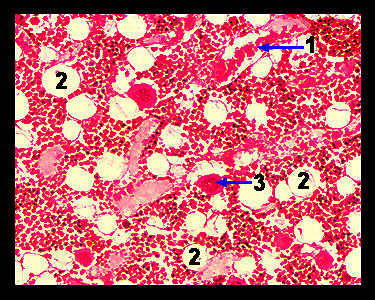|
|
||||||||||||||||||||||||||||||||||||||||||||||||||||||||||||||||||||||||||||||||||||||||||||||||||||||||||||||||
|
This slide shows a section of red bone marrow. The formed elements of the blood are produced in red marrow by the process of hemopoiesis. Specifically, red bone marrow is the site of formation and maturation of the erythrocytes, monocytes, granulocytes (neutrophils, eosinophils, and basophils) and platelets. Some lymphocytes are also produced in the red marrow, with the rest being produced in the thymus, spleen and lymph nodes. The primary location of red marrow in adults is the spongy bone of the axial skeleton, the girdles and the proximal epiphyses of the humerus and femur. Red marrow tissue consists of a network of reticular fibers, blood vessels and many cell types. The major type of blood vessel is called a sinusoid through whose walls formed elements enter into the bloodstream. The cells of red marrow are of many types and are scattered irregularly throughout the tissue. The vast majority of them are erythrocytes, granulocytes, and monocytes in various stages of development. However, mature erythrocytes and granulocytes are found scattered throughout the marrow tissue. Many of the sinusoids may be filled with mature red blood cells. There are also numerous adipose cells scattered throughout the red marrow. In life these cells are filled with fat, but when the slide is prepared, the fat is lost leaving a nearly circular open space. Also note the giant megakaryocytes with their large multilobed nuclei. These cells will eventually rupture to produce many tiny platelets. |
|
